Here is a summary of some of the more basic instructions for the kafka test I installed in the CDH.
1. Related Basic Contents
Each host in the Kafka cluster runs a server called a proxy that stores messages sent to the subject and serves consumer requests.
First, look at the instance information of the server installing kafka:
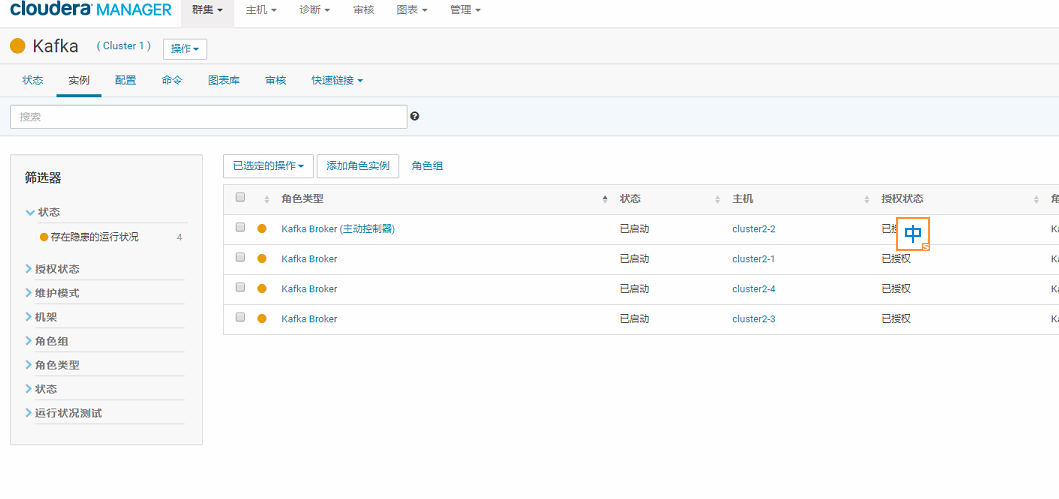
Be careful:
Then the instructions for normal Kafka are:. /bin/kafka-topics.sh --zookeeper cluster 2-4:2181....
However, Kafka installed with CDH does not need to write out this. /bin/kafka-topics.sh section entirely.Just writing kafka-topics directly is an important difference, so pay special attention when installing Kafka using CDH.
What instructions can you see in this path?
/opt/cloudera/parcels/KAFKA-4.1.0-1.4.1.0.p0.4/bin
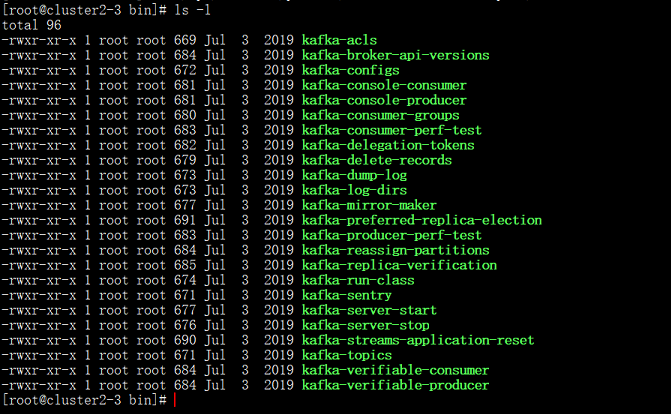
2. topic Theme Use
Next, to test the top directive, let's first look at the scope of the Kafka service for this ZooKeeper Root configured in the CDH: "/kafka".
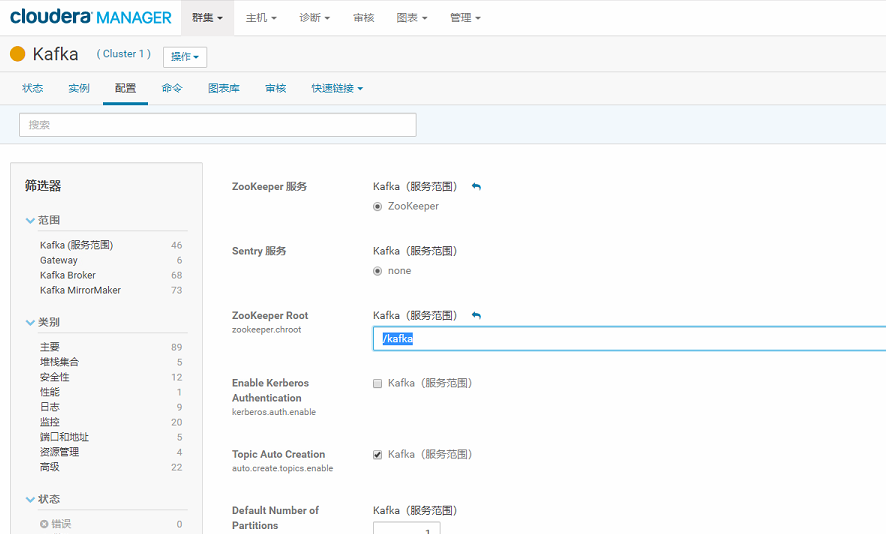
So the format of instructions we use top should be similar:
kafka-topics --zookeeper cluster2-4:2181/kafka ......
A. Create a topic called test (Topic):
kafka-topics --zookeeper cluster2-4:2181/kafka --create -replication-factor 1 --partitions 3 --topic test

Or
If the above ZooKeeper Root's Kafka service scope is: "/".The Create Theme directive here changes to:
kafka-topics --zookeeper cluster2-4:2181 --create --replication-factor 1 --partitions 3 --topic test
B. Query topic s that already exist:
kafka-topics --zookeeper localhost:2181/kafka --list

C. Delete the created topic:
kafka-topics --zookeeper localhost:2181/kafka --delete --topic test2

Expand:
Topic *** is marked for deletion is output if deleted directly here.
Method 1: Modify the kafaka configuration file server.properties, add delete.topic.enable=true, restart kafka, and then delete the topic directly from the Kafka command line.
Method 2: Delete the topic from the command line:. /bin/kafka-topics.sh --delete --zookeeper {zookeeper server} --topic {topic name}
_Because server.properties in the kafaka configuration file is not configured with delete.topic.enable=true, deletion is not really deleted at this time, it just marks top as marked for deletion. You can view all topics by command:. /bin/kafka-topics --zookeeper {zookeeper server}--list
Method 3: If you really want to delete it, you need to log in to the zookeeper client:
zookeeper-client
_Find the directory where topic is located:
ls /kafka/brokers/topics
Execute the command, and the top is completely deleted:
rmr /kafka/brokers/topics/{topic name}D. Modify the number of topic partitions:
kafka-topics --zookeeper localhost:2181/kafka --alter --topic test \ partitions 5

E. View topic details:
kafka-topics --describe --zookeeper localhost:2181/kafka --topic test

Here we can also test if the distribution is connected properly:
kafka-topics --zookeeper cluster2-4:2181/kafka --list kafka-topics --zookeeper cluster2-3:2181/kafka --list

You can see that in 2-4 this server, we can get uniform information by entering cluster2-4:2181/kafka and cluster2-3:2181/kafka later.
topic directive parameters:
Option Description
------ -----------
--alter Alter the number of partitions,
replica assignment, and/or
configuration for the topic.
--bootstrap-server <String: server to REQUIRED: The Kafka server to connect
connect to> to. In case of providing this, a
direct Zookeeper connection won't be
required.
--command-config <String: command Property file containing configs to be
config property file> passed to Admin Client. This is used
only with --bootstrap-server option
for describing and altering broker
configs.
--config <String: name=value> A topic configuration override for the
topic being created or altered.The
following is a list of valid
configurations:
cleanup.policy
compression.type
delete.retention.ms
file.delete.delay.ms
flush.messages
flush.ms
follower.replication.throttled.
replicas
index.interval.bytes
leader.replication.throttled.replicas
max.message.bytes
message.downconversion.enable
message.format.version
message.timestamp.difference.max.ms
message.timestamp.type
min.cleanable.dirty.ratio
min.compaction.lag.ms
min.insync.replicas
preallocate
retention.bytes
retention.ms
segment.bytes
segment.index.bytes
segment.jitter.ms
segment.ms
unclean.leader.election.enable
See the Kafka documentation for full
details on the topic configs.It is
supported only in combination with --
create if --bootstrap-server option
is used.
--create Create a new topic.
--delete Delete a topic
--delete-config <String: name> A topic configuration override to be
removed for an existing topic (see
the list of configurations under the
--config option). Not supported with
the --bootstrap-server option.
--describe List details for the given topics.
--disable-rack-aware Disable rack aware replica assignment
--exclude-internal exclude internal topics when running
list or describe command. The
internal topics will be listed by
default
--force Suppress console prompts
--help Print usage information.
--if-exists if set when altering or deleting or
describing topics, the action will
only execute if the topic exists.
Not supported with the --bootstrap-
server option.
--if-not-exists if set when creating topics, the
action will only execute if the
topic does not already exist. Not
supported with the --bootstrap-
server option.
--list List all available topics.
--partitions <Integer: # of partitions> The number of partitions for the topic
being created or altered (WARNING:
If partitions are increased for a
topic that has a key, the partition
logic or ordering of the messages
will be affected
--replica-assignment <String: A list of manual partition-to-broker
broker_id_for_part1_replica1 : assignments for the topic being
broker_id_for_part1_replica2 , created or altered.
broker_id_for_part2_replica1 :
broker_id_for_part2_replica2 , ...>
--replication-factor <Integer: The replication factor for each
replication factor> partition in the topic being created.
--topic <String: topic> The topic to create, alter, describe
or delete. It also accepts a regular
expression, except for --create
option. Put topic name in double
quotes and use the '\' prefix to
escape regular expression symbols; e.
g. "test\.topic".
--topics-with-overrides if set when describing topics, only
show topics that have overridden
configs
--unavailable-partitions if set when describing topics, only
show partitions whose leader is not
available
--under-replicated-partitions if set when describing topics, only
show under replicated partitions
--zookeeper <String: hosts> DEPRECATED, The connection string for
the zookeeper connection in the form
host:port. Multiple hosts can be
given to allow fail-over. 3. Testing producer to produce data and consumer consumption data
After we created topic before, here's a test of how to use kafka-console-producer and kafka-console-consumer in Kafka to produce data and consume data on the other end.
You also need to understand the proxy structure in the publish-subscribe system here:

producer generates data into Topic, and consumer consumes data from Topic to consume.
- Start producer first:
kafka-console-producer --broker-list cluster2-4:9092 --topic test

- Enter the data here and it will be uploaded to the / kafka/broker/test topic in zookeeper.
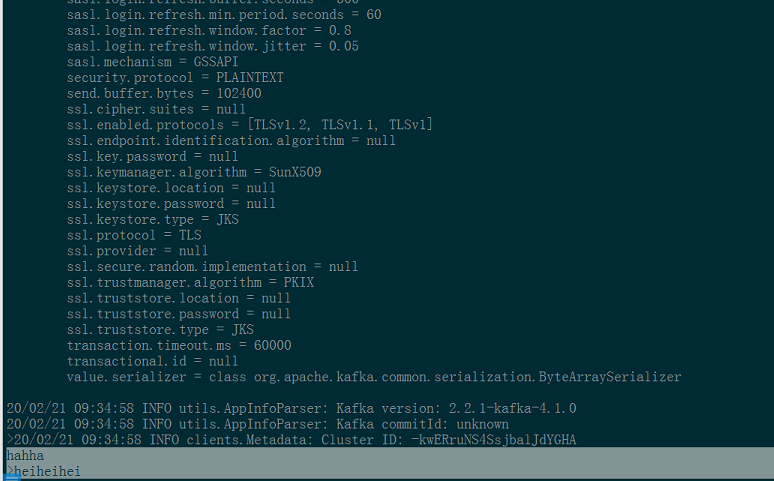
Instruction parameters for the kafka-console-producer producer:
Option Description
------ -----------
--batch-size <Integer: size> Number of messages to send in a single
batch if they are not being sent
synchronously. (default: 200)
--broker-list <String: broker-list> REQUIRED: The broker list string in
the form HOST1:PORT1,HOST2:PORT2.
--compression-codec [String: The compression codec: either 'none',
compression-codec] 'gzip', 'snappy', 'lz4', or 'zstd'.
If specified without value, then it
defaults to 'gzip'
--help Print usage information.
--line-reader <String: reader_class> The class name of the class to use for
reading lines from standard in. By
default each line is read as a
separate message. (default: kafka.
tools.
ConsoleProducer$LineMessageReader)
--max-block-ms <Long: max block on The max time that the producer will
send> block for during a send request
(default: 60000)
--max-memory-bytes <Long: total memory The total memory used by the producer
in bytes> to buffer records waiting to be sent
to the server. (default: 33554432)
--max-partition-memory-bytes <Long: The buffer size allocated for a
memory in bytes per partition> partition. When records are received
which are smaller than this size the
producer will attempt to
optimistically group them together
until this size is reached.
(default: 16384)
--message-send-max-retries <Integer> Brokers can fail receiving the message
for multiple reasons, and being
unavailable transiently is just one
of them. This property specifies the
number of retires before the
producer give up and drop this
message. (default: 3)
--metadata-expiry-ms <Long: metadata The period of time in milliseconds
expiration interval> after which we force a refresh of
metadata even if we haven't seen any
leadership changes. (default: 300000)
--producer-property <String: A mechanism to pass user-defined
producer_prop> properties in the form key=value to
the producer.
--producer.config <String: config file> Producer config properties file. Note
that [producer-property] takes
precedence over this config.
--property <String: prop> A mechanism to pass user-defined
properties in the form key=value to
the message reader. This allows
custom configuration for a user-
defined message reader.
--request-required-acks <String: The required acks of the producer
request required acks> requests (default: 1)
--request-timeout-ms <Integer: request The ack timeout of the producer
timeout ms> requests. Value must be non-negative
and non-zero (default: 1500)
--retry-backoff-ms <Integer> Before each retry, the producer
refreshes the metadata of relevant
topics. Since leader election takes
a bit of time, this property
specifies the amount of time that
the producer waits before refreshing
the metadata. (default: 100)
--socket-buffer-size <Integer: size> The size of the tcp RECV size.
(default: 102400)
--sync If set message send requests to the
brokers are synchronously, one at a
time as they arrive.
--timeout <Integer: timeout_ms> If set and the producer is running in
asynchronous mode, this gives the
maximum amount of time a message
will queue awaiting sufficient batch
size. The value is given in ms.
(default: 1000)
--topic <String: topic> REQUIRED: The topic id to produce
messages to.- Then start the consumer:
kafka-console-consumer --bootstrap-server cluster2-3:9092 --topic test --from-beginning
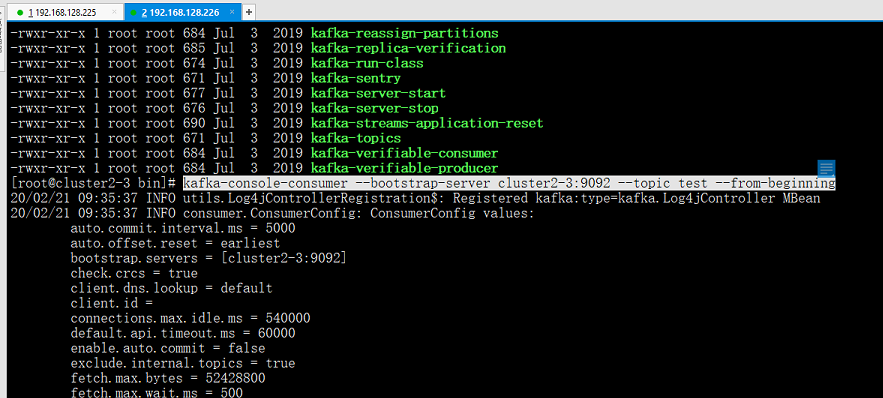
The following --from-beginning indicates that all partitions will be consumed starting from a valid starting displacement location in the specified topic.
- Data consumers consume to top:
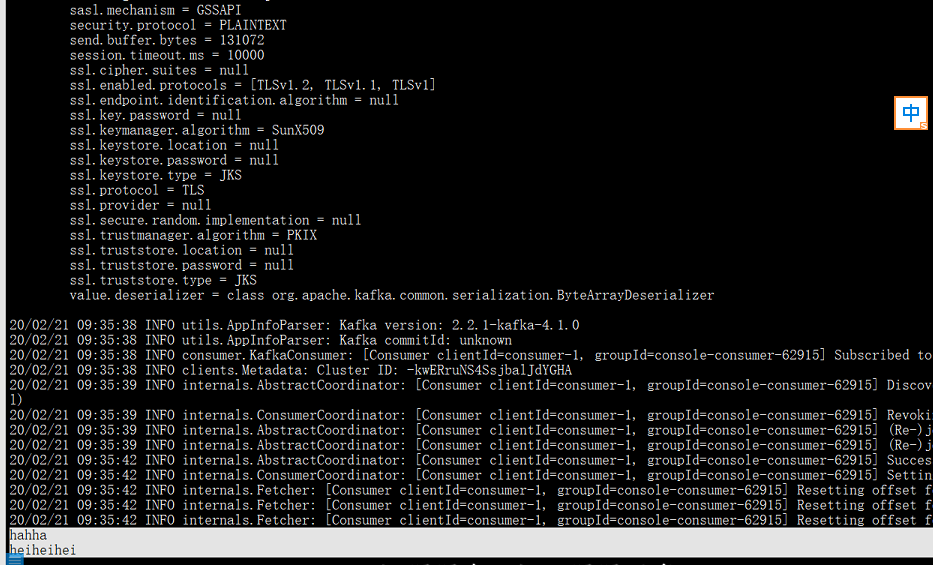
Instruction parameters for kafka-console-consumer consumers:
Option Description
------ -----------
--bootstrap-server <String: server to REQUIRED: The server(s) to connect to.
connect to>
--consumer-property <String: A mechanism to pass user-defined
consumer_prop> properties in the form key=value to
the consumer.
--consumer.config <String: config file> Consumer config properties file. Note
that [consumer-property] takes
precedence over this config.
--enable-systest-events Log lifecycle events of the consumer
in addition to logging consumed
messages. (This is specific for
system tests.)
--formatter <String: class> The name of a class to use for
formatting kafka messages for
display. (default: kafka.tools.
DefaultMessageFormatter)
--from-beginning If the consumer does not already have
an established offset to consume
from, start with the earliest
message present in the log rather
than the latest message.
--group <String: consumer group id> The consumer group id of the consumer.
--help Print usage information.
--isolation-level <String> Set to read_committed in order to
filter out transactional messages
which are not committed. Set to
read_uncommittedto read all
messages. (default: read_uncommitted)
--key-deserializer <String:
deserializer for key>
--max-messages <Integer: num_messages> The maximum number of messages to
consume before exiting. If not set,
consumption is continual.
--offset <String: consume offset> The offset id to consume from (a non-
negative number), or 'earliest'
which means from beginning, or
'latest' which means from end
(default: latest)
--partition <Integer: partition> The partition to consume from.
Consumption starts from the end of
the partition unless '--offset' is
specified.
--property <String: prop> The properties to initialize the
message formatter. Default
properties include:
print.timestamp=true|false
print.key=true|false
print.value=true|false
key.separator=<key.separator>
line.separator=<line.separator>
key.deserializer=<key.deserializer>
value.deserializer=<value.
deserializer>
Users can also pass in customized
properties for their formatter; more
specifically, users can pass in
properties keyed with 'key.
deserializer.' and 'value.
deserializer.' prefixes to configure
their deserializers.
--skip-message-on-error If there is an error when processing a
message, skip it instead of halt.
--timeout-ms <Integer: timeout_ms> If specified, exit if no message is
available for consumption for the
specified interval.
--topic <String: topic> The topic id to consume on.
--value-deserializer <String:
deserializer for values>
--whitelist <String: whitelist> Regular expression specifying
whitelist of topics to include for
consumption.

